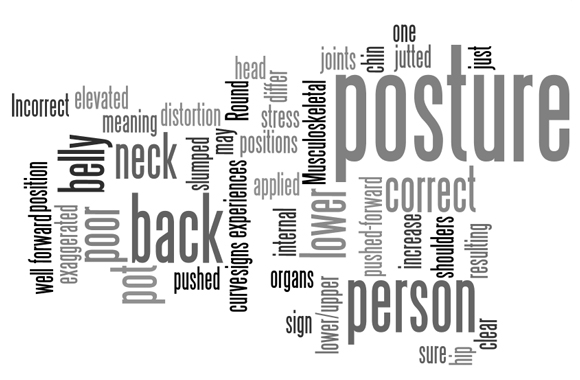To do, or Not to do?
It’s not what we aren’t doing that is slowly wreaking havoc on our bodies. It’s what we are doing that can often be more of a danger to our overall well-being. The way we do things repeatedly shapes and molds us over time and leads us down roads of discomfort and even pain. We are continually told we need to add this, do that, add more, and expand by doing more of that. But what if the starting line is: you tweak what you are already doing?
We have all heard the word “posture” before, and I can assume you probably have an idea of what that word means. But just for the sake of the few that may not be clear, our friend Google says that posture is “the position in which someone holds their body when standing or sitting.” Posture is how we carry our body, how we move or don’t move our body, posture is where our parts go, and how they stack or don’t stack; all constitute posture.
And as a movement and fitness leader for 15 years now, I have seen a wide variety of interpretations of what posture is, and I have also encountered many that have not drawn the line between how they feel and posture itself.
Here’s the thing, you can add all the exercises, fancy shoes, even nice furniture you want. Still, if your posture is off or tainted, those additions will temporarily mask the underlying issue that truly is a simple (but diligent) fix.
So here are 4 ways to improve your posture TODAY:
1. Look at your feet. If you are walking forward, they should be pointing forward. Ankle, knee, and hip (even neck) problems often stem from the feet. Pointing them forward takes the load off the knees and gives the lower back and hips a break. Also, consider the type of shoes you are wearing. The higher the heel, the bigger the risk for possible foot, hamstring, and hip problems.
2. Where’s your pelvis? A lot of what our pelvis does correlates back to our feet, but on a basic level, you want your pelvis in what is called “neutral.” Neutral is a home-based position for your body, bringing your pelvic floor (the basement of your core) back underneath you, your organs, back into their very strategically stacked position, and finally, give relief to your hip flexors and lower back.
How do you find neutral? Your front hip bones (also known as your Anterior Superior Iliac Spine) can be found by the front belt loops of your pants. Your pubis bone resides where the zipper would land if you would unzip a pair of jeans. These three bony landmarks make an upside-down triangle that should run parallel with the wall you are facing. NOTE: Doing this in heels will show you how much your body is adapting to a posture that is not natural.
3. Look to your core – many separate working the core into its own workout. Even with yoga, students still ask, “can we do core work,” like it is somehow separate from the rest of the body. The thing is, core work isn’t something you do. It’s everything you do. So that means that even while standing, walking, running, even sitting, you can engage your core-yes, even while you work!
Remember the neutral pelvis? Let’s consider that position, the footings of the house, your rib cage, the roof of the house, and your “core” (what is in the middle), the house’s walls. Now your walls don’t stand a chance if the footings and roof are off-kilter. And you can do all the core work you want, but if your structure is out of balance, you could be doing more harm than good. Look at your front ribs; as you exhale, work to relax your front rib cage down. Doing this is a game-changer when it comes to the activation of the core daily. You don’t need to feel the “burn” all day, every day but having your core engaged in what I call a “low idle” is ideal, so when your movements request more help, it’s ready for action.
4. Bring it back, your shoulders, that is. That good ole saying our mothers and grandmothers taught us was exactly right. Except that they forgot a critical piece—what to do with the front of the body when you bring your shoulders back. Most will squeeze their shoulders together back behind them and never give any attention to what the front of the body is then doing about that “squeeze.”
Sitting tall (hopefully on your Move or Variable chair), feel your shoulder blades move down and slightly toward the spine, but as you do that, pay attention to your front lower ribs; what do they do? For many, they flare outward and forward like shutters opening on a window. When this happens, it leaves your core’s roof out of balance and crooked. When the roof is off, the core cannot function properly.
The next time you bring your shoulder down and back, also remember to keep your front rib cage down and in. This requires core control. I call that a win for sure! Then with your ribs and pelvis in better alignment, your core has instant activation.
Before deciding to reinvent the wheel, adding in dozens of new exercises, and expensive gadgets, consider simply looking at your day-to-day posture to find out what can easily be done. The above can be practiced sitting, standing, even walking or running. Posture is your body’s blueprint and will help you eliminate potential injuries and hopefully keep pain and discomfort at bay.
With Posture, it’s the little things that add up to big, lasting results. This is exactly what I love about the Move sit-stand stool and Variable kneeling chairs. I fell in love with these chairs because sitting on them with poor posture is virtually impossible. These ergonomic chairs force you to sit up with better posture than a standard chair. Combined with the small tweaks I talked about above, these chairs become a powerful tool for you to feel better, sit taller, and incorporate unconscious core work simply by using your core as it was designed.
Have a Core-ageous Day!
This post is part of our Ambassador series.

Hope’s mission is to help others purposefully excel. Her own early struggle with a life-threatening eating disorder and then the loss of her first child led her to realize that her name is not just a name, but a symbol. Hope has helped change thousands of lives over the past 15 years, going beyond her experience in the fitness and wellness industry.



